Ukraine’s German-made Leopard 1A5 tanks are rolling toward the front line. A video that appeared online on Sunday depicts one of the 40-ton, four-person tanks on a muddy road on a rainy day apparently somewhere in Ukraine.
The Leopard 1A5’s arrival in Ukraine, nine months after a German-Dutch-Danish consortium first pledged the 1980s-vintage tank, is good news for the Ukrainian war effort. With nearly 200 Leopard 1A5s delivered or about to be delivered, the type is set to become Ukraine’s most numerous Western-style tank.
The Leopard 1A5 has accurate fire-controls and a reliable 105-millimeter main gun that’s compatible with a wide array of effective ammunition.
But there’s something ominous in that first video of a Leopard 1A5 apparently near the front line in Ukraine. The tank seemingly isn’t wearing any add-on armor. No cage to protect it from drones. No bricks of reactive armor to defeat incoming missiles and shells.
And to be clear, the Leopard 1A5 definitely needs add-on armor. With steel armor that’s just 70 millimeters thick at its thickest, the Leopard 1A5 could be the least-protected tank in Russia’s 22-month wider war on Ukraine. Even Russia’s 1950s-vintage T-55s and Ukraine’s equally aged, but upgraded, M-55Ss are better-protected in certain aspects than a Leopard 1A5 is.
The Ukrainians know how to up-armor a tank—and there are reasons to believe they eventually will apply this know-how to their growing fleet of Leopard 1A5s.
Consider what the Ukrainian army did with its Leopard 2A4s, German-made tanks that are of similar vintage as the Leopard 1A5s and also share the 1A5’s fire-controls—but which are 20 tons heavier than the Leopard 1s are. Armor accounts for much of that extra weight.
Even so, the army added reactive armor to most of its initial batch of 40 Leopard 2A4s, which equip a battalion with the 33rd Mechanized Brigade, one of the lead units in Ukraine’s five-month-old southern counteroffensive. Reactive armor explodes outward when struck, potentially dissipating an incoming round.
Up-armoring a tank with ERA takes time. Technicians must weld racks onto a vehicle before they can hang the ERA bricks. The racks and the armor they support must not interfere with optics and the turret-traverse.
All that is to say, adding reactive armor is easier said than done. It also depends on a steady supply of ERA bricks. Installing cage armor might be somewhat easier, as the cages are inert.
In any event, the first Leopard 2A4s rolled into action this summer without extra armor. It wasn’t until September that we saw video evidence that the 33rd Brigade had added ERA to all of its active Leopard 2s. It’s apparent Ukrainian workshops lack the capacity to up-armor a lot of tanks, fast.
This shortfall might not be a problem for Ukraine’s best-protected tanks—its Strv 122s, Leopard 2A6s, Challenger 2s and M-1s. But it definitely is a problem for its worst-protected tanks.
If an intensive effort to install ERA for some reason proves unsupportable, there is an alternative. German firm IBD Deisenroth Engineering produces an add-on armor kit for tanks and other vehicles it calls MEXAS.
The Canadian army added MEXAS to its own Leopard 1s for the tanks’ final few years of service, nearly 20 years ago. By all accounts, MEXAS at least doubles a vehicle’s protection.
Read the full article here





